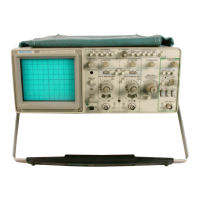Triggering on Low-Frequency Signals
Use the NORM trigger mode for signals that are lower than 20 Hz in NON
STORE or 500 Hz in STORE. If the repetitive signal is lower than these
frequencies, the P-P AUTO circuit interferes with obtaining a stable trigger.
This is because the P-P AUTO circuit will start to generate its own signal to
trigger a sweep or acquisition.
{Note: NORM trigger mode is not the same as COUPL NORM.)
□ Step 1: Apply the repetitive signal to the Channel 1 input connector.
□ Step 2: Set trigger mode to NORM and the horizontal mode to A.
F I Step 3: Set the vertical mode to Channel 1 and the trigger SOURCE to
VERT MODE. (The trigger signal is obtained from the signal applied to
the selected channel; in this case, Channel 1.)
□ Step 4: Set the COUPL switch to NORM.
□ StepS: Adjust the TRIGGER LEVEL and VAR HOLDOFF, if necessary,
to stabilize the display.
[~[ StepS: Adjust the vertical and horizontal controls to display a few
cycles of the waveform.
["1 Step 7: Set the oscilloscope to STORE mode (Figure 3-25). Note that
the annoying flicker of the NON-STORE display is removed.
AU1i=0,00U j TRIG 1 = 0 .SU &t=
i
| j
j |
|
I
>(
1 C
1 1
i 1
!
1
1
! I
1U |
pdflKDE.T SBms
Figure 3-25: Low-Frequency Signal in the STORE Mode
Triggering on Random or Infrequent Events
Sometimes the event that you want to display occurs very infrequently. The
oscilloscope can be set up to capture these events. Refer to Capturing
Random Events, page 3-12.
3-26
In Detail

